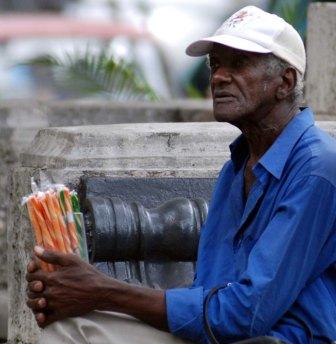Our Street Vendors

They were born in the economic crisis of the 1990s, at a time when the government was scrambling in its capacity as employer. They existed previously, but hardly in the same numbers as today. They came to be known as “merolicos”, a word meaning “informal vendor,” which was added to the Cuban vocabulary from a Mexican soap opera.
These street vendors, who were often people with physical disabilities, sold homemade products of clearly poor quality, but which were in short supply in the state run markets and stores. Their wares included coffee makers, fingernail polish and remover, deodorants, pots, Tupperware-like products and a long list of products ranging from plaster piggy banks to pink lawn flamingos.
Now such peddlers have sprouted like dandelions. They can be found everywhere, from the exits of hospitals to the entrances of homes, mainly in the Central Havana and Marianao neighborhoods of Havana. This informal sector has expanded prolifically, an empirical expression that poverty -if only at a Cuban scale- has also increased, a fact that is also maintained by sociologists and other academics.
This now involves a diverse market in which a certain degree of trade specialization prevails. Today I’ll deal with one of these traders: the sellers of bootleg CDs.
Crouched down in portals or near bus stops, these “other” merolicos display products that, at first sight, can be surprising in their variety and diversity. For a relatively moderate price -let’s say two Cuban Convertible Pesos, or a little over two US dollars- one can find burnt CD copies ranging from popular local artists (like Van Van, Paulito FG or Kelvis Ochoa) all the way to the globalized sounds of Madonna and Britney Spears, but especially Puerto Rican reggaeton rappers Daddy Yankee and Don Omar.
In addition, they will of course be hawking Cuban artists from across the Strait (Gloria Estefan, Willy Chirino, Celia Cruz), who are noticeably absent from Cuban airwaves for political reasons.
Several Cuban musicians who have exploded into the market call this piracy, and they complain that the practices of the merolicos affect their income.
However, the question at hand is to what extent the new phenomenon expresses the global contradiction between the democratization of culture brought by new technology and the production oligopolies -whose prices distance many peoples access to cultural goods-, and in this case impeding possession of the music that they themselves generate).
“Here we are,” wrote author Nicolás Guillén in a famous prologue. These new merolicos have come to stay, because the angel of the informal market also flaps its wings here, just like in Madrid, Mexico City, Santo Domingo and Lima.






Sometimes the pirates who counterfeit DVD’s actually have good taste! (Either that, or they don’t know what they are reproducing.) A few years back I was able to purchase a copy of Fellini’s “Dolce Vita” (1961) on the street for $3! (Through Criterion or Olive Films it costs significantly more.)
In the future I hope street vendors could again sell high quality–but low cost, locally produced–products, instead of trashy toys and cheap touristic tchotchkes from China. Looking down from my perch on an upper floor of the Hotel Roosevelt, Amistad y San Miguel, Centro, in the summer of 1959, I remember street vendors selling flowers, bread, vegetables and all sorts of refreshments; each hawker had his or her own unique and melodic call, and some of these inspired sones, or vice versa. I’d watch them as the apartment dwellers opposite the Roosevelt would, from their balconies, lower baskets and haul them back up from the street. On recent trips in Santiago and Trinidad early mornings, after 47 some years, I was again awakened to these pleasant melodies.
With unemployment reaching frightening levels up here, street sales may again be an option, as it was during the Great Depresion. This time, however, I hope it will be more than apples and shoe shines (most shoes nowadays can’t be shined, anyway!) Maybe shots of expresso, or impromptu haikus, or, for those folks with artistic talent, caricature sketches, like the street artists of Habana Vieja.
This is a good discussion of an economically modest yet socially significant element in the daily reality of Cuba today since it’s also the kind of thing which nearly never is discussed in the official media. One sees a million times more of this in Mexico City and other places than in Cuba, but this phenomenon is by no means absent from the island, either. Sometimes these people are hassled, sometimes not.
Among the most familiar ones are the old people who take bundles of daily newspapers and sell them for a slight markup, but they’re delivered directly to you, or hawked on the street. There’s no such thing as any left-over newspapers in Cuba at the end of the day, except for the spare copies which they keep at the newspaper offices for file purposes. More than a few people supplement their meager official incomes in this way.